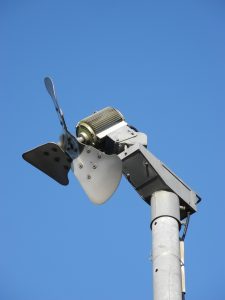 If you look at a Japanese tea field, you’ll often see what looks like tall posts with small fans on top.
If you look at a Japanese tea field, you’ll often see what looks like tall posts with small fans on top.
Have you wondered what they are for?
The first thing that comes to mind is that maybe they are used for cooling. However, it’s the opposite. The fans are there to raise the temperature!
Frost Prevention Fans
This device is called bousou fan (防霜ファン). As it’s name implies, this device is used to avoid frost damage in crops.
In tea fields, the idea is to protect the leaves of young shoots born in the spring. These are the highest quality tea leaves (shincha), so any damage at this point costs a lot of money.
The frost prevention fans are usually placed 3 to 5 meters (about 10 to 16 feet) high, use electric power and are slanted towards the ground. Another cool feature is that they have a thermal sensor, so they save energy by turning on only when needed.
Alright, so how does the frost protection fan work?
The science behind frost prevention fans in tea fields
Through the effect of radiative cooling, heat is radiated into space from the ground on cloudless nights. Sometimes it gets cold enough as to form ice on top of objects.
Have you noticed that frost forms in your lawn even when the air temperature is above the freezing point? This happens because the temperature of the ground is actually colder than the air temperature that we measure.
Cold air is denser than hot air, so it stays on the ground while hot air rises. In fact, air at 6 meters (19.6 feet) can be 4 to 6 degrees Celsius hotter than the temperature at ground level.
That’s where the frost prevention fan comes into play. It pushes the upper layers of hot air into the ground so that frost can’t form and damage the tea leaves.
To cover a bigger area, all you need is more fans.
As a bonus, I’m including a short a video where you can see the frost prevention fans:





May 28, 2013
Fascinating, never heard of these, or seen them. Interesting explanation, as I too associate fans more with cooling than heating.
July 5, 2013
Interesting,
October 30, 2014
This is interesting. I ride the Kintetsu line from Osaka to Nagoya almost daily and have seen these fans for years then just today decided to look it up and found this article.
October 30, 2014
Hi Ashwin
Thanks for the comment, and for finding my article 🙂
October 29, 2015
same as Ashwin – I have been wondering. thanks for satisfying my curiosity
October 30, 2015
Hi Marco
Thanks for the comment.
June 1, 2017
Thanks very much for writing this. My family were in Kirishima and were puzzling over those fans.
June 1, 2017
Thank you for your comment Marc, I’m glad to be of help.
December 23, 2019
That’s what we guessed when we saw these fans on the way to Kirishima Shrine from Yusui. Thank you for the explanation. It’s good to see there are so many fans of Japanese tea.